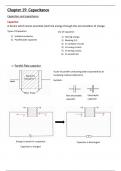Capacitors and capacitance
Capacitor
A device which stores essential electrical energy through the accumulation of charge.
Types of Capacitors: Use of Capacitor:
1) Isolated conductor 1) Storing energy
2) Parallel plate capacitor 2) Blocking D.C.
3) In oscillator circuits
4) In tuning circuits
5) In timing circuits
6) To smooth AC
Parallel Plate capacitor
A pair of parallel conducting plates separated by an
insulating medium (dielectric).
Symbols:
Non electrolytic Electrolytic
capacitor capacitor
Energy is stored in a capacitor. Capacitor is discharged.
Capacitor is charged.
, 1) Initially the plates are uncharged.
• Each plate has equal amounts of positive and negative charges, hence neutral.
2) By connecting the capacitor to a supply, the supply does work in separating the charges:
• The supply transfers electrons from the plate connected to the positive terminal of the
battery to the plate connected to the negative terminal.
Or (alternative explanation)
• The supply pulls charge +Q from one plate from one plate and transfers it to the other,
leaving behind a -Q charge.
3) The plates are charged.
• The two plates store charges of equal magnitude but opposite in polarity.
• The total charge on the entire capacitor is still zero.
4) The current stops when the potential difference across the capacitor is equal to the electromotive
force (e.m.f) of the supply.
The capacitor is fully charged.
To make the capacitor plates store more charge, use a supply of higher emf.
Capacitor stores energy but not charge
▪ Since charges on both plates are equal in magnitude and opposite in polarity.
▪ Hence there is no resultant charge. Hence charge is not stored.
▪ Energy is stored because there is a charge separation between plates due to work done by the power
supply.
, Isolated Conducting Sphere
The current flows until V = EHT.
Capacitance of a capacitor
Capacitance
General Definition: Ratio of charge stored to potential difference across it.
For a parallel plate capacitor:
• The capacitance is the ratio of the charge on one plate to the potential difference between the
plates of the conductor.
𝑐ℎ𝑎𝑟𝑔𝑒 𝑜𝑛 𝑜𝑛𝑒 𝑝𝑙𝑎𝑡𝑒
𝐶=
𝑝. 𝑑. 𝑏𝑒𝑡𝑤𝑒𝑒𝑛 𝑡ℎ𝑒 𝑝𝑙𝑎𝑡𝑒𝑠
For an isolated conductor:
• The capacitance is the ratio of the charge on conductor to the potential at surface of conductor.
𝑐ℎ𝑎𝑟𝑔𝑒 𝑜𝑛 𝑐𝑜𝑛𝑑𝑢𝑐𝑡𝑜𝑟
𝐶=
𝑝𝑜𝑡𝑒𝑛𝑡𝑖𝑎𝑙 𝑎𝑡 𝑠𝑢𝑟𝑓𝑎𝑐𝑒 𝑜𝑓 𝑐𝑜𝑛𝑑𝑢𝑐𝑡𝑜𝑟
𝑄
𝐶=
𝑉
Q: charge/ C Unit of Capacitor: farad (F) / CV-1
1F = 1CV-1
V: potential difference/ V
C: capacitance/ F


